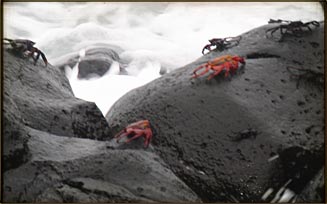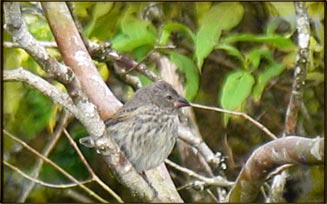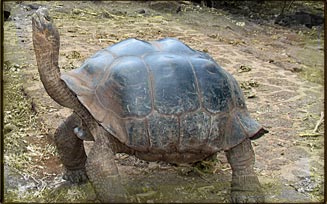
|

September
10, 2004
Preparing for Galapagos
As a producer and science writer for the Exploratorium, I’ve
investigated science at some pretty amazing places: astrophysics
at the South Pole, genetics at Cold Spring Harbor Laboratory,
and marine biology under the ice in Antarctica. But for a
biologist, there is no more historically significant destination
than the Galapagos Islands. These stark, volcanic islands,
600 miles off the coast of Ecuador, are the birthplace of
modern biological thought. The scientific transformation came
at the hands of Charles Darwin, who visited the Galapagos
in 1835 and collected some of its unique animals and plants.
Darwin studied and ruminated over his unusual collection for
25 years before he synthesized his thoughts on evolution.
Radical at the time, and sometimes still controversial, Darwin’s
theory is widely accepted and virtually unmodified by scientists
nearly 150 years later. In
The Origin of Species
,
Darwin proposed that the mechanism of evolution is natural
selection, in which the organisms that are best adapted to
their environment survive to produce offspring. As environmental
circumstances change, some species die out, others survive
and evolve.
What,
exactly, inspired Darwin’s ideas on natural selection?
The Galapagos Islands, like many of the world’s isolated
archipelagos, are showcases for evolution. Few terrestrial
organisms are hardy enough to swim, fly, or float to these
remote chunks of land and the ones that do, called founder
species, find a biological blank slate. The founders adapt
and evolve to take advantage of available resources, fanning
out and creating new species with unique characteristics that
are found nowhere else on earth. Galapagos is famous for these
unique, or endemic, species: long-necked giant land tortoises
whose shell patterns differ from island to island, the world’s
only iguana that swims and feeds in the sea, the only flightless
cormorant, and 13 species of affiliated birds known as Darwin's
finches.
El
Niño in the Galapagos
Recognized by the government of Ecuador as a unique treasure
of natural history, the Galapagos Islands have been under
protection since 1959 (the 100-year anniversary of
The
Origin of Species
). Ecotourists flock there to see many
of the creatures that inspired Darwin’s famous theory,
including flamingos, penguins, whales, and the striking blue-footed
bobbies, a unique species of bird noted for its elaborate
mating rituals and cerulean feet. I hope to see some of these
animals myself, but the real purpose of my visit is to document
a conference that is using Galapagos as a showcase of another
sort: one in which native residents, environmental stewards,
and scientists use climate information to balance the needs
of society and ecosystems.
The focus
of the conference is on early warning systems and knowledge
about the climate fluctuation known as El Niño, more
formally called El Niño/Southern Oscillation, or ENSO.
ENSO begins when normally cool eastern Pacific ocean waters
off the coast of South America and the Galapagos Islands warm
up and the trade winds slacken. This prevents nutrient-rich
deeper waters from coming to the surface, disrupting the food
chain for fish and other marine fauna and flora. It can also
dramatically disrupt rainfall patterns, causing flooding and
changes in vegetation. In the Galapagos, these changes can
be good for tortoises (the rainfall increases vegetation,
their food source) but bad for marine iguanas (warm water
kills off brown algae, which they depend on, and increases
green algae, which is toxic to the iguanas).
Climate
Affairs and Sustainable Development
ENSO is not just a local phenomenon in the eastern Pacific,
it also has dramatic and far-reaching impacts on human and
natural communities throughout the Pacific Rim and the world,
which is why this conference is drawing scientists and policy
experts from China, Australia, Chile, England, and the U.S.
Social scientist and conference organizer Michael Glantz from
the National Center for Atmospheric Research explains that
El Niño is a spawner of climate anomalies and climate-related
hazards around the globe. He notes that with good forecasts
there are things communities can do — such as cleaning
up dry river beds, shoring up bridges and buildings, and repairing
roads and rail lines — to reduce hazards.
But, he
adds, the point is to get beyond disaster response and compiling
of lessons learned and find ways to use climate forecasting
and early warning systems to increase the resilience of communities
and ecosystems against climate disturbances, and to foster
sustainable development. “We’re good at identifying
problems, but not at learning from them. I want to move the
discussion up from the science and into the social realities.
I haven’t done this before; it’ll be one of the
harder meetings I’ve organized.”
For inspiration,
Glantz likes to quote the young protagonist in Mark Haddon’s
novel
The Curious Incident of the Dog in the Night-Time
:
“I
said that I wasn’t clever. I was just noticing how things
were . . . that was just being observant. Being clever was
when you looked at how things are and used the evidence to
work out something new.”
|



